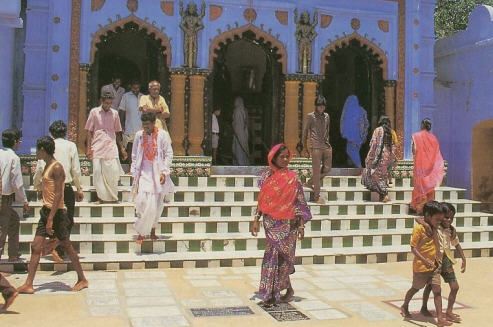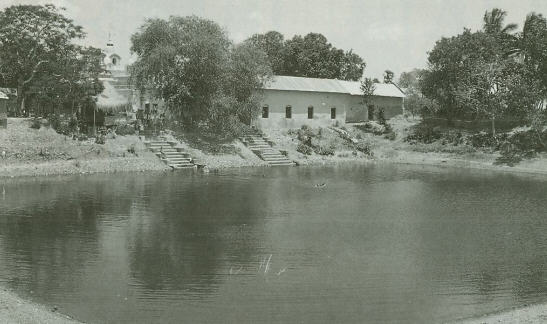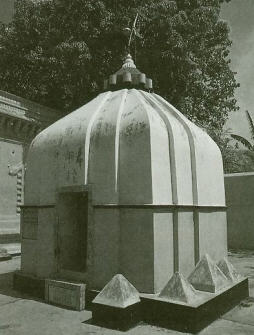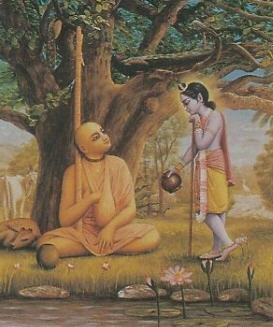
At this temple in Orissa, the Deity is famous as a thief.
REMUNA IS A TINY VILLAGE in Orissa, but it's quite a busy place, with people coming and going all the time. All the action centers on the temple of Ksira-cora Gopinatha.
We have come to Remuna just at the end of the Candana-yatra, when the Deities are smeared with cooling sandalwood pulp (candana). During the hottest time of the day, the priests apply candana to the chest of the temple's three Krsna Deities: Madana-mohana, Govinda, and Gopinatha. On one day (Aksaya-trtiya) Their whole bodies are smeared.
At Remuna, each day starts at 4:00 A.M. with chanting of the Hare Krsna mantra, played from a cassette over loudspeakers in the temple compound. The cassette, produced by ISKCON Calcutta, is popular all over Bengal and Orissa.
Another pleasing feature of the temple is that the people in charge are genuinely pleased to welcome visitors. This reminds us of Remuna's long tradition of welcoming devotees. We read in Caitanya-caritamrta of how well Madhavendra Puri and Lord Caitanya were received here.
Seeing The Lord's Form
The pujari (priest) told me, "You must come and see the dressing of the Deities at 6:30 in the morning." So we went. To be allowed to see the dressing of a Deity is rare, but here everyone can come see. Gopinatha appears carved from a piece of stone, like a bas-relief, except that most of His form is visible. (See "How the Deity Came to Remuna, p. 27.) On the stone are other figures, said to be carved by Lord Krsna in His incarnation as Lord Ramacandra. The pujari showed us these figures.
We also found out why Gopinatha's flute looks rectangular, as you can see in His photo, rather than cylindrical: the flute you see covers the original flute, which is rectangular and is part of the Deity.
As the dressing began, only Maha-Visnu Dasa and I were there to watch. Gradually a few more people came, everyone looking intensely at the beauty of the Deities. We sat chanting on our beads, drinking through our eyes the beauty of Govinda, Gopinatha, and Madana-mohana. (The Deities of Govinda and Madana-mohana were brought here from Vrndavana about 1938 by a devotee named Caitanya Dasa Babaji.)
The pujari quickly and expertly dressed the Deities using simple cloth, which he twisted and turned to make an attractive outfit.
Remuna's Holy Sites
I first came to Remuna in 1978. The place now is more developed. Nothing grand, but there are a few shops, and many more people come to see the Deity. Many come to arrange for sons and daughters to be married in the temple.
Pilgrims come in a steady flow throughout the day, but no big crowds like the ones you'll find at Puri, Tirupati, or Nathadwar. Probably a few hundred pilgrims a day visit here, a thousand or so on Sundays. We are here in the summer, when there are not so many visitors. In the winter, when the weather is cool, more people come, mostly from Orissa and Bengal. Many people who visit belong to various Gaudiya Vaisnava sects, groups of followers of Lord Caitanya. Several Gaudiya families have settled here.

Previously Remuna was directly on the route between Bengal and Puri. Now it's slightly off the route. The main rail line goes through Baleshwar, twelve kilometers east. The original route still exists and is known as Gaura-danda, "the path touched by the holy feet of Lord Caitanya."
The Gopinatha temple stands in an area by itself in the fields, about half a kilometer from the village of Remuna. At the main entrance to the temple, a bakul tree with huge branches marks a spot said to be the site of the first temple, built by King Narasimhadeva.
About two hundred meters from the present temple, near the temples of Ramacandi and Gargasvara, there used to be a village market. The local people say it belonged to a cowherd village where every day the villagers gave sixty liters of milk to make Gopinatha a spiced condensed milk called amrta-keli. The market, it is said, is where Madhavendra Puri stayed when he came to Remuna. (See "How Gopinatha Got the Name Ksira-cora," p. 32.) Madhavendra Puri's sitting place and wooden shoes are worshiped at a small temple at the spot. The temple is the samadhi (tomb) of Madhavendra Puri.
In two places at the Gopinatha temple, pilgrims worship the footprints of Caitanya Mahaprabhu. The footprints are modeled after the ones in the Jagannatha temple in Puri, where Caitanya Mahaprabhu would stand next to the Garuda-stambha, the pillar holding Garuda, the eagle carrier of Lord Visnu. It is said that Lord Caitanya felt such intense ecstasy upon seeing the Jagannatha Deity that His feet melted impressions into the stone floor.
A little shop at the Gopinatha temple sells books in Oriya, Bengali, and English telling about the glories of the temple. The shop sells photos of Gopinatha (for visitors to photograph the Deity is prohibited). The shop also sells sweets to offer the Deity. After being offered, the sweets are given back to the person who bought them, a common system in India.
Just outside the entrance to the temple is a small manmade pond. It has steps going down to it so one can reach it to bathe. Another pond, a very old one, about a hundred meters from the temple, is where devotees from Bengal would bathe on the way to see Lord Caitanya in Puri. Caitanya Mahaprabhu, Nityananda Prabhu, Madhavendra Puri so many great souls must have bathed here. And now we are so fortunate to get that chance. Although the pond has become the local place where people come to wash their clothes, the spiritual benefit of bathing there remains.
About a ten-minute walk from the temple of Ksira-cora Gopinatha is a branch of the Gaudiya Math, the mission of Srila Bhaktisiddhanta Sarasvati Thakura, Prabhupada's spiritual master. When he came here just a few years before he left this world, he wanted to start a branch of his mission here but did not accomplish that desire. Shortly after he left this world, however, someone donated for the Gaudiya Math in Remuna a 300-year-old Jagannatha temple. Besides the Jagannatha deities, the temple is now the home of Radha-Krsna Deities originally installed by Srila Bhaktisiddhanta Sarasvati in Mymensingh, in what is now Bangladesh. The Radha-Krsna Deities were brought here when Bengal was partitioned.
The Remuna area is also the birthplace of Sridhara Svami, the original commentator on Srimad-Bhagavatam, and Baladeva Vidyabhusana, a great spiritual master in the line of Lord Caitanya. You can visit their birthplaces if you can find someone to guide you; most of the local people don't seem to know about these places.
Tasting The Nectar
Last night I was able to fulfill a long-held desire to read the story of Ksira-cora Gopinatha in front of the Deity Himself. By good fortune, someone here had a copy of the Caitanya-caritamrta, and I was able to read that in front of the Deity. Eight devotees arrived from Mayapur today on their way to Puri, and they have asked me to read the story to them tonight.
Remuna is famous for the condensed milk called amrta-keli, which is very sweet. And we enjoy another kind of sweet nectar here the Caitanya-caritamrta. Both of these sweet nectars are enjoyable at Remuna the place of transcendental pleasure.
Bhakti Vikasa Swami comes from England but has lived in India for many years. He now teaches Krsna consciousness at the ISKCON center in Baroda, Gujarat.
How the Deity Came to Remuna
SRI KAISORANANDADEVA Gosvami, a disciple of Rasikananda (see sidebar, p. 29), wrote a book in Oriya, the language of Orissa, telling how the Gopinatha Deity came to Remuna.

Diety of Ksira-Cora Gopinatha
The book relates that in Treta-yuga, more than a million years ago, the Supreme Lord Ramacandra and His wife, Sita Devi, lived for some time at Chitrakut, in north central India. (See BTG, Jan/Feb 1993.) Once during the rainy season a strong storm forced Rama and Sita to take shelter in the asrama of some sages. On seeing the many cows in the asrama and hearing their mooing, Lord Ramacandra told Sita, "Seeing all these cows, I'm reminded of My pastimes in Dvapara-yuga." Lord Rama was referring to His later appearance as Lord Krsna.
Sita Devi said, "What do You mean? Please tell me about those pastimes."
Lord Rama replied, "Just wait a week. With an arrow I'll carve some pictures of those pastimes in a black rock, and you will be able to see them."
But after four days Sita said, "I can't wait any longer. Please show me what You've done."
To please her, Lord Ramacandra then showed her the carvings. He had completed a Deity of Gopala Krsna (His back still attached to the stone) and, on the stone itself, drawings of Krsna's eight principal gopis(cowherd girlfriends) and four maid-servants to the gopis. Also depicted were twelve cows, Lord Balarama wrestling Mustika, Lord Krsna wrestling Canura, and a few other scenes.
Pleased to see all this, Sita began worshiping the Gopala Deity at Chitrakut.
After a few days Rama and Sita left, so Lord Brahma, the creator of the universe, came and took over the worship of the Deity (a service he was to perform through the rest of Treta-yuga, through Dvapara-yuga, and for several centuries of Kali-yuga).
When Lord Ramacandra returned to India from Lanka after killing the demon Ravana, He stopped for four days at the place now known as Remuna. Sita Devi wanted to bathe there in the Ganges, so Lord Rama shot seven arrows into the ground and brought forth the Ganges. Today that place is called Saptashara, "seven arrows." A deity of Lord Siva named Gargasvara was later installed there. Near-by stands a deity of Durga Devi known as Ramacandi. Because Lord Ramacandra felt pleasure (ramana) at that place, it came to be known as Remuna.
In the thirteenth century King Langula Narasimhadeva from Orissa was traveling to holy places with his queen and many great sages. At Chitrakut they saw the Deity of Gopala. Not knowing that Lord Brahma was coming there daily, the king was astonished that no one was worshiping such a beautiful Deity.
That night the Deity appeared to the king in a dream and asked to be taken to a more populated place. The king decided to take Gopala to Jagannatha Puri.
The king selected some qualified brahmanas to worship the Deity and started for Puri. But when they reached Remuna, a beautiful cowherd village, Gopala again appeared to the king in a dream and asked to be installed and worshiped there. The village people, delighted, gave the Deity large quantities of milk and milk products every day. The queen noticed that the Deity was accompanied by carvings of the eight principalgopis, so she named Him Gopinatha, "Lord of the gopis."
Rasikananda, a Great Devotee of Lord Gopinatha

NOT LONG AFTER the time of Caitanya Mahaprabhu, a king who was a Deity hater was going around smashing Deities in temples. When the people of Remuna heard he was coming, they hid Gopinatha in a pond three miles away. The king was upset that he could not find Gopinatha, so he struck and partially broke Ramacandi, the Durga deity.
Meanwhile, a great devotee named Rasikananda received an order in a dream to excavate the pond where Gopinatha had been hidden. He recovered the Gopinatha Deity, built a temple for Him, and took charge of His worship.
Rasikananda was the foremost disciple of Syamananda, who had helped transport from Vrndavana to Bengal the writings of the Gosvamis, leaders in Lord Caitanya's movement. Syamananda had spread Krsna consciousness extensively in Orissa, where Rasikananda had become his disciple.
When Rasikananda decided it was time to leave the world, he went into the Gopinatha temple and disappeared. He had been performing sankirtana in the temple courtyard with seven of his associates, and now his associates were so overwhelmed by spiritual separation that they too gave up their bodies and entered the spiritual world.
The samadhis (tombs) of Rasikananda and these associates stand outside the temple. Each spring the people of Remuna hold a twelve-day festival to commemorate the passing of Rasikananda.
Visiting Remuna
THE BEST WAY to get to Remuna from Calcutta is to take a train from Howrah station to Baleshwar, about a five-hour trip, depending on the train. From Baleshwar you can go the twelve kilometers to Remuna by taxi, auto riksha, or bus.
There's a small guesthouse at the Gopinatha temple, and there are some good hotels in Baleshwar.
You can get prasadam at the Gopinatha temple at midday and in the evening. You reserve your meal by paying in advance. You'll get a plate of rice, dal, chutney, and two vegetable dishes.
The temple's famous spiced condensed milk is available in the afternoon and evening, in small, medium, and large pots.
Tumultuous Worship
EVENING ARATI (worship) at the Ksira-cora Gopinatha temple is spectacular. Just before 7:00 P.M. the curtain draws closed. Two pujaris in the Deity room bang gongs, someone in the courtyard bangs a big drum, and a kirtana group sings and plays mrdanga drums and karatalas (hand cymbals), all together making a tremendous sound.
At seven the curtain is whisked open. Everyone outside the Deity room offers obeisances, and the kirtana picks up again with full volume. The pujari offers incense and camphor while a second pujari stands behind him waving a camara (yak-tail whisk). Although the temple always has electricity, during the arati a man holds a traditional torch of oil-soaked cloth.
After the pujari has offered the incense, the curtain is closed while he lights the ghee lamp. Meanwhile the kirtana goes on, and when the door opens, the kirtana becomes intense bang! bang! bang!
The pujari offers the ghee lamp and then water in a conch shell. When he finishes, he walks through the kirtana courtyard, throwing the water on both sides, as all the devotees offer obeisances to get the water on their heads. The arati lasts about ten minutes.
How Gopinatha Got the Name Ksira-cora
THE NAME "Ksira-cora" means "one who stole condensed milk." When Lord Caitanya visited the Gopinatha temple in Remuna, He told the devotees traveling with Him how the Deity had come to receive that name. Lord Caitanya had heard the story from His spiritual master, Isvara Puri, a disciple of Madhavendra Puri. As related in Caitanya-caritamrta, it is Madhavendra Puri for whom the condensed milk was stolen.

Madhavendra Puri was a highly advanced devotee of Lord Krsna. While living in Vrndavana absorbed in remembering the pastimes of the Lord, he saw Krsna appear in a dream and tell him He had been buried for a long time in a jungle nearby. Krsna wanted Madhavendra Puri to dig Him up. Following the Lord's instruction, with the help of the local people Madhavendra Puri discovered a Deity of Krsna named Gopala.
Madhavendra Puri built a temple for Gopala and served Him for two years. Then again one night Gopala appeared to him in a dream and asked him to go to Orissa to get sandalwood to smear on His body.
On the way to Orissa, Madhavendra Puri stopped at the Gopinatha temple in Remuna. He asked the priest what kind of food was offered to Gopinatha, thinking he could offer the same preparations to his own Deity, Gopala. The priest mentioned the condensed milk (ksira) known as amrta-keli, which was famous because its taste was nectarean.
That evening, while the priest made an offering to the Lord, Madhavendra Puri thought that if the priest were to offer him some of the condensed milk he could taste it and then be able to prepare it for Gopala. He then at once became ashamed for thinking of tasting the Lord's food during the offering. Feeling he had committed a great offense, he left the temple and went to a vacant marketplace to chant the names of the Lord.
Later that night, the Gopinatha Deity appeared in a dream to the priest and told him He had hidden a pot of condensed milk behind His cloth. Gopinatha told the priest to deliver the condensed milk to a saintly person named Madhavendra Puri. The priest did as told.
Madhavendra Puri felt ecstasy to learn that the Lord had stolen condensed milk for him. After drinking the milk, Madhavendra Puri kept the pot, and every day he would eat a little piece of it.
